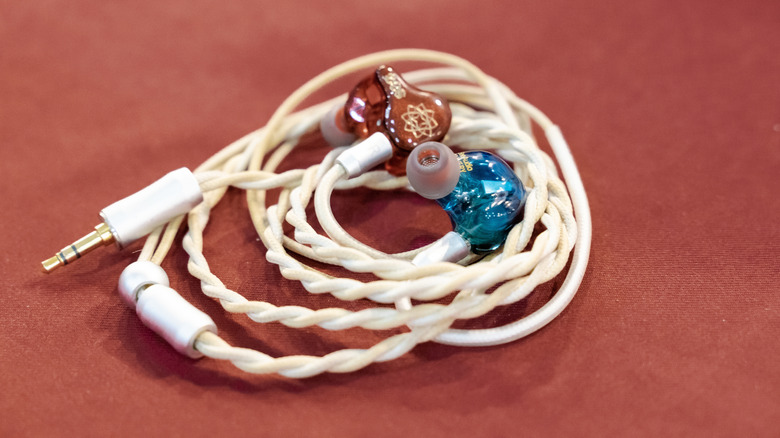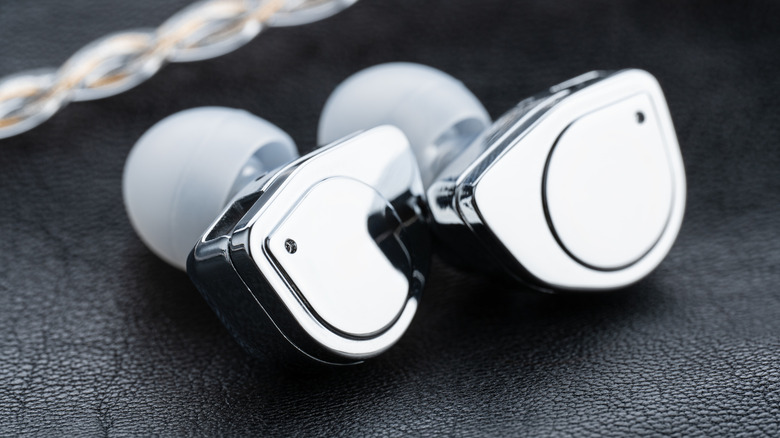IEMs Vs. Wired Earbuds: What's The Difference Between These Earphones?
Although almost every smartphone manufacturer has ditched the headphone jack, wired earbuds still have their place for those in pursuit of sonic perfection, and the subcategory of IEMs is a cornerstone of the professional audio world. Even the best wireless earbuds cannot transmit audio without some form of compression that impacts quality, and Bluetooth also introduces latency that impedes audio workflows. For these and other reasons, audio professionals and hobbyist audiophiles continue to rely on wired earbuds in certain scenarios. Spend enough time around audio engineers, stage musicians, or high-grade audio enthusiasts, and you're sure to hear the term IEM crop up in reference to certain wired earbuds. So, what are IEMs, and who should consider them?
IEM stands for in-ear monitor. The term is self-explanatory: in-ear means the earpiece is inserted into the ear canal, while a monitor is an audio playback device designed for analytical listening, also known as monitoring. The best studio monitors typically take the form of large speakers, but when on stage or on the go, a more portable and personal solution is often required. IEMs are there to fill the gap, providing high-quality audio in a pocketable package. The distinction between a wired earbud and an IEM is generally based on their design and purpose, although some may argue over semantics, and the line often blurs. So, here's how you can distinguish between the two.
IEMs are for audio professionals and enthusiasts
While all IEMs are wired earbuds, not all wired earbuds are IEMs. The term is generally reserved for earbuds that penetrate into the ear canal and are meant for professional use. There are different kinds of IEMs, but it initially referred to those designed for stage performances. If you've ever been to a concert and noticed the artist wearing an earbud that loops out and over their ear, that's a stage monitor IEM. They're used to make sure the artist can hear the music they're performing over the noise of the crowd. Some audio engineers are also known to wear IEMs when mixing music on the go without access to studio monitors. Some will even use IEMs in a studio in order to hear how their mixes sound on both large speaker systems and tiny earbud drivers. This can help them get a better sense of the audio dynamics.
There are two types of IEMs: custom and universal. Custom IEMs are made based on a mold of the owner's ear taken by an audiologist to ensure a perfect fit that leads to improved acoustic isolation. Non-custom IEMs are called universal IEMs, and they are more like the earbuds most people are used to, with one-size-fits-all silicone or foam ear tips. IEMs can range widely in price from around $100 to multiple thousands of dollars, though quality does not necessarily have a linear correlation with price. Some well-known IEM brands include Ultimate Ears (the company's main product before launching its popular line of Bluetooth speakers), Moondrop, Sennheiser, and others, comprising a range of established and newcomer brands as the market for IEMs continues to expand.
Wired earbuds are an umbrella category for IEMs and more
Although the type of specialized in-ear earbuds described above is what most audio professionals think of when they hear the term IEM, there are competing definitions. Some say that IEM simply refers to any earbud that goes into the ear canal rather than resting in the outer ear. By that definition, basic EarPods are not IEMs, but even crummier, off-brand, $5 buds with silicone tips are. You can see why some audio enthusiasts don't find this definition entirely convincing. It's therefore more useful to define IEMs by their intended purpose. As with studio-grade headphones, IEMs aim for a flat response, meaning the sound signature of the audio is not adjusted to sound better for consumer listening.
Consumer earbuds, on the other hand, often tweak their frequency responses to appeal to market preferences. For instance, many consumer earbuds advertise elevated levels of bass, but while that might be desirable for Spotify listening, it's anathema to an audio professional trying to make sure a bass guitar is properly mixed into a song. IEMs may also feature higher-quality drivers — the miniature speakers inside the buds — and more drivers compared to other wired earbuds. Think of it like the difference between a luxury car and a race car. The former has a variety of comfort-focused features designed for a pleasurable driving experience on any road, while the latter maintains a bare-bones focus on accuracy and speed in a specialized environment. Many music fans may not require the clinical precision that high-end IEMs aim for, and would likely derive more enjoyment from a pair of consumer earbuds.


